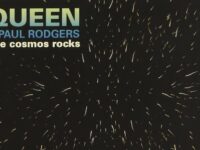Freddie Mercury, talking about his band Queen, once compared them to the sweeping Hollywood auteur Cecil B. DeMille, and he wasn’t that far off.
The group, which also included guitarist Brian May, bassist John Deacon and drummer Roger Taylor, was a heady mixture of heavy metal, prog, power pop, disco and show-tune bombast — and their shows were just as outsized. Conducting it all was the late Mercury. One of music’s most distinctive and flamboyant front men, he boasted a opera-singer’s range, a rock star’s ballsy attitude and the unfettered exhibitionism to put on these transfixingly Dionysian live performances.
After a fallow period for record sales in the late 1980s, Queen saw a resurgence in popularity around the time of Mercury’s early death in 1991 from complications related to the AIDS virus. The following year, the hit film “Wayne’s World” then introduced the band to a new generation by prominently featuring “Bohemian Rhapsody.”
Queen has sold more than 32 million albums in the U.S. alone, half of them since Mercury’s death, according to the Recording Industry Association of America. Estimates of the group’s worldwide record sales to date are as high as 300 million; Queen’s Greatest Hits remains the best selling album of all time in the UK.
Yet, Queen is somehow often left out when talk turns to era-defining classic rock bands — perhaps because they’ve always been so hard to pin down. We’re here to make the argument for Mercury and Co. …
“SPREAD YOUR WINGS/SHEER HEART ATTACK” (NEWS OF THE WORLD, 1977): One of my favorite things about Queen was their ability to play tough hard rock as well as more anthemic material and yet make them both believable.
While “We Are The Champions” probably counts as quintessential Queen, I’ve always been drawn to “Spread Your Wings.” I can’t deny that there’s a little burnout factor with the former tune, but that’s not the whole story. “Spread Your Wings” kicks off with a simple piano accompanying Freddie’s vocals before Brian May’s layered guitars slowly fill in the spaces. Mercury’s singing is its usual powerful self but it’s given a lot of lift by those bombastic guitars. On “Sheer Heart Attack,” which may or may not be a reaction to the punk music of the day, vicious chugging power chords provide relentless, surging energy.
By the time you get to the nervous guitar squeals that usher in the phase-shifted drum break, any doubts you might have had about Queens ability to rock out should be in hiding. —Mark Saleski
“STONE COLD CRAZY” (SHEER HEART ATTACK, 1974): I can only imagine what the experience of popping Queen’s Sheer Heart Attack on the turntable in 1974 and hearing “Stone Cold Crazy” come blasting out of the speakers was like.
Fans of Queen’s first two records certainly wouldn’t have been surprised by a heavier tune. There were plenty of metallic sounds on Queen II, a personal favorite of mine. But this was something completely different. This was a sound, like much of Queen’s genius, that was nearly a decade before its time.
If you had to pinpoint when thrash metal was born, there’s no better place to start than with “Stone Cold Crazy.” It was released nearly a year before Black Sabbath’s proto-thrasher “Symptom of the Universe,” and fits the genre so well that when Metallica covered it in the early 1990s, they copied it pretty much note for note — and it sounded like a song tailor-made for them. I’m guessing there’s not a thrash guitarist out there who hasn’t played that riff a few times and wished he had written it.
But the real argument is in the energy and aggression of the song itself. It opens with Brian May leaning on the whammy bar, then Roger Taylor smacks his snare the first time to signal things are about to blow up. That’s followed by the high-speed main riff with a chunky guitar sound from May that rips your face off. Taylor’s frenetic drumming matches the intensity. A little later on the track, May returns to melt the face he’s ripped off with some smoking lead lines laden with trippy effects. It’s one of the rare instances in Queen’s history where the flamboyant Freddie Mercury takes a back seat to the primal power of May’s guitar.
The song’s simplicity adds to its strength. One could make a good argument that “Ogre Battle” from Queen II had the first thrash sounds, but they were couched in the over-the-top theatrics to which the band was prone. “Stone Cold Crazy,” on the other hand, had one purpose — to kick ass and the hell with even bothering to take names. Mission accomplished. — Fred Phillips
“RADIO GA GA” (THE WORKS, 1984): In their two decades or so recording, Queen managed to do almost everything they could to not explicitly sound like Queen, and yet nothing they released was ever mistaken for anything but them. How many groups have ever been capable of making that kind of unmistakable stamp upon their music, and then just unleashed, unprepared, their music upon their hyper-dedicated fans who simply went along for the wild, weird ride with the band? It seems like such a remarkable thing these days — bands being given the kind of freedom to explore the edges of metal, opera, disco, new wave … Queen really seemed to know no bounds.
But none of this meant anything to me back in 1984 when “Radio Ga Ga” was released. It was just one of a small rotation of videos that played on a local TV station’s attempt at their own version of the then blossoming MTV — which we didn’t yet get on our cable system. At some point, I’d decided to make my own mix of the songs I liked and I made do: I saw the song come on and I hoisted my little boombox up to the TV, pressed play/record simultaneously, and captured onto cassette my own little stolen copy of the song in what was probably the worst way possible. It didn’t even cross my mind to look for a single, or even the album. It sounded terrible but my crappy TV-speaker boombox recording sufficed just fine. All wanted was to hear that song again, whenever I wanted.
I don’t know what about it attracted me at the time. I listen now and hear the results of progress in Queen — burbling synth bass and washes, augmented by live bass and drum machine, plus just enough acoustic piano to lend a melody to the music. It’s even lacking any kind of significant guitar contribution from the great Brian May, who is relegated background guitar and some very light soloing. It doesn’t sound, on paper, very “Queen-like.” And yet, it’s distinctly Queen. This, like many of Queen’s later efforts, places more reliance upon Freddie Mercury’s astonishing, emotive vocals to build an air of grand, regal elegance around a simple pop song. I couldn’t have known that at the time, but I, like so many others who got hooked by Queen, undoubtedly felt it.
The older I get, the more I appreciate Queen. The funny thing about this is, for ages, I didn’t really consider myself much of a Queen fan. When asked, I’d say I didn’t really know or care that much for their music. I was wrong. It turns out we actually go way back. — Tom Johnson
“THE PROPHET SONG” (A NIGHT AT THE OPERA, 1975): Admittedly, I was a late-comer to Queen. It was the use of “Bohemian Rhapsody” in Wayne’s World that initially caught my interest. I picked up A Night At the Opera and was blown away not just by “Rhapsody” but also “The Prophet’s Song.” The vocal harmonies are absolutely brilliant.
What Queen did with this song was way ahead of its time. The stereo effects on the acapella section take the song to another level. This, and “Bohemian Rhapsody,” are certainly the most musically adventurous songs on the album, and perhaps the most musically adventurous material Queen ever recorded. — Perplexio, from DancingAboutArchitecture and The Review Revue
“UNDER PRESSURE,” with David Bowie (HOT SPACE, 1982): Stop, collaborate and listen: It’s time to take this song back from Vanilla Ice.
“Under Pressure” was, without question, the highlight of Hot Space, a curiously ineffective mix of disco, funk and R&B. The result of an impromptu jam session (thus the song’s writing credit for all five partipants), the track is still defined by John Deacon’s legendary bass line — a squiggly revelation, even before David Bowie and Freddie Mercury begin verbally joisting, trading their own self-written verses in a dizzying game of over-the-top showmanship. The song eventually ramps up into this classic Queen anthem — right as Mercury cries why can’t we give love, give love, give love — signalling a complete return to mid-1970s form, but on the very last song of a stutteringly uneven release.
“Under Pressure” would shoot to No. 1 in the UK. But even then, as Bowie outlined the “terror of knowing what this world is about,” who could have really guessed what lay ahead? Just five days after this single was originally released, Robert Van Winkle (nee’ Vanilla Ice) would celebrate his 14th birthday. No word on whether little Robert wore his hat sideways at the party. — Nick DeRiso
- Ernesto Cervini’s Turboprop, “When I Fall” (2024): Video premiere - March 15, 2024
- Disaster Pony,“Dead Neon & The Noon Sun” from ‘Disaster Pony’ (2024): Video premiere - February 27, 2024
- Christopher Hoffman, “Farewell Forever” from ‘Vision Is The Identity’ (2024): Streaming premiere - February 19, 2024




